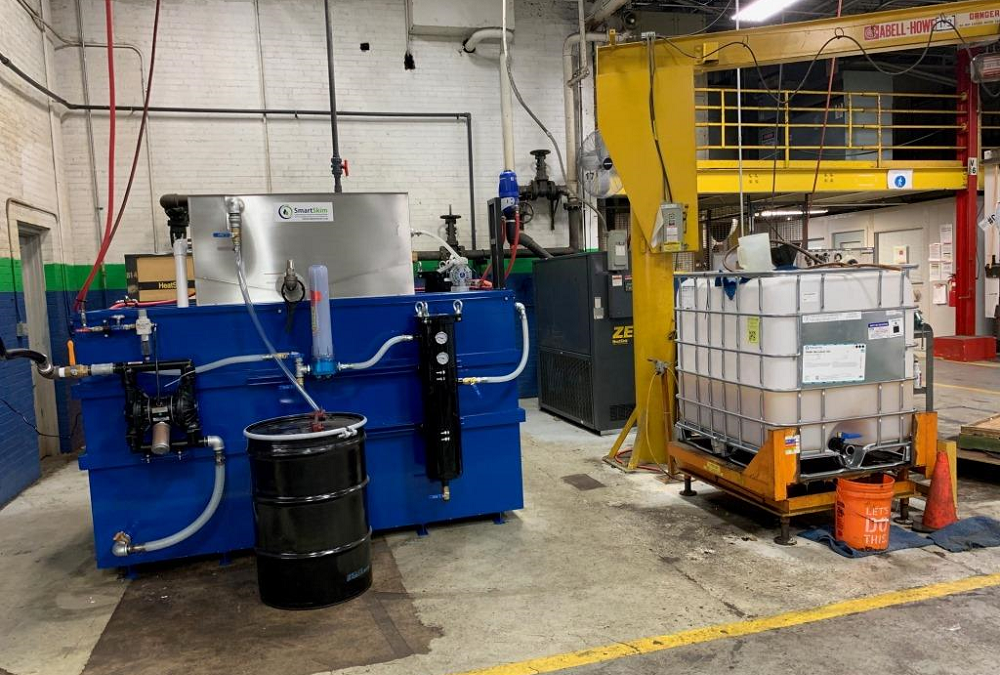On average, the cost of cutting fluid comprises less than 1% of a manufacturer’s budget, but it directly affects almost every aspect of a manufacturer’s operation. Many manufacturers seek to improve their production by recycling their cutting fluid to extend its useful life, lower waste disposal, and improve coolant performance. Let’s look at the numbers.
The Standard Cutting Fluid Life Cycle
In most manufacturing operations, cutting fluid’s life cycle looks something like this:
- Manufacturers select and purchase an appropriate cutting fluid concentrate or straight oil.
- They then charge the sump with coolant at the recommended concentration and use it to carry out operations.
- During use, fluid concentration changes due to carryoff and evaporation forcing machine operators to “top up” the machines with new coolant to maintain proper concentration.
- The fluid begins to collect tramp oil and other contaminants from machining, reducing quality and performance.
- Chips from workpieces and other debris also collect in the sump, further lowering fluid quality while also creating an environment for bacterial growth.
- Soon, the coolant becomes so contaminated that it’s no longer usable. Tramp oil causes odors, residues, and increased usage. Contaminants reduce lubricity and cooling ability. Bacteria produces a strong odor that fills the shop. Operators increase concentration and usage to combat these issues until they have no choice but to empty out the sump, dispose of it, and recharge it with a new batch of coolant.
Leading to high fluid usage and disposal, this approach has a number of disadvantages:
- A high fluid consumption rate
- Excessive machine downtime and fluid maintenance costs
- Reduced productivity and finite fluid performance
- High disposal costs and waste volume
Cutting Fluid Recycling Systems to the Rescue
Master Fluid Solutions® pioneered cutting fluid recycling systems in the 1970s and completely changed the way manufacturers look at coolant. The specialized recycling equipment removes contaminants from the fluid so it performs like new, for longer periods of time, while significantly reducing waste and cutting fluid spend. Still, many manufacturers choose to weigh whether to invest in fluid recycling because it:
- Has upfront costs: Purchasing and implementing cutting fluid recycling systems can require investments in both time and capital.
- Adds complexity: Operations must incorporate steps in the production process to account for fluid recycling and coolant maintenance duties.
- Unsure of the ROI: Manufacturers may not fully understand the recycling process, how to implement best practices and what cost and usage reductions they will realize.
Cost, fluid consumption, and disposal savings can be significant — especially over time and easily justify the cost of a recycling system providing a quick ROI. Selecting a cutting fluid partner who is proficient in fluid recycling is a great first step. With proper fluid management and recycling, one manufacturer saved $2.65 million!
Another company, a Thailand-based hard-drive disk manufacturer, struggled with a poor sump life. Fluid contamination accumulated quickly, leading to frequent coolant replacement, increasing machine downtime and decreasing productivity. Even with frequent cleanouts, the customer struggled with bacteria growing in the sump and spreading odor throughout the workshop.
The manufacturer installed a XYBEX® coolant recycling system to purify the cutting fluid, without the need for a total sump cleanout and replacement. In a short time, the customer reduced overall fluid consumption by 50%. As consumption decreased, disposal costs also went down by more than 80%. Since the implementation of the XYBEX system and training from Master Fluid Solutions experts, the manufacturer has only had to do one sump cleanout in a three-year period.
Cutting Fluid Recycling: Saving More Than Money
Cutting fluid recycling systems dramatically reduce fluid consumption, saving money on coolant and reducing machine downtime in the process. Manufacturers also enjoy other benefits from the enhanced fluid performance. With better lubricity, cooling, and fluid cleanliness, cutting tools’ life is improved. As sustainability becomes an increasingly important KPI for manufacturers around the world, reducing coolant waste plays a crucial role in achieving those goals.
Ready to save more money on cutting fluid? Contact one of our distributors to learn more about how your shop can benefit from a XYBEX fluid recycling system.

